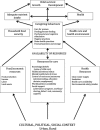Women's empowerment and child nutritional status in South Asia: a synthesis of the literature
- PMID: 24850533
- PMCID: PMC6860351
- DOI: 10.1111/mcn.12125
Women's empowerment and child nutritional status in South Asia: a synthesis of the literature
Abstract
Women's disempowerment is hypothesised to contribute to high rates of undernutrition among South Asian children. However, evidence for this relationship has not been systematically reviewed. This review of empirical studies aims to: (1) synthesise the evidence linking women's empowerment and child nutritional status in South Asia and (2) suggest directions for future research. We systematically searched Global Health, Embase (classic and Ovid), MEDLINE, Campbell Collaboration, Popline, Eldis, Web of Science, EconLit and Scopus. We generated 1661 studies for abstract and title screening. We full-text screened 44 of these, plus 10 additional studies the authors were aware of. Only 12 studies fulfilled our inclusion criteria. We included English materials published between 1990 and 2012 that examined the relationship(s) of at least one women's empowerment domain and nutritional status among South Asian children. Data were extracted and synthesised within three domains of empowerment: control of resources and autonomy, workload and time, and social support. The results showed women's empowerment to be generally associated with child anthropometry, but the findings are mixed. Inter-study differences in population characteristics, settings or methods/conceptualisations of women's empowerment, and the specific domains studied, likely contributed to these inconsistencies. This review also highlights that different women's empowerment domains may relate differently to child nutritional status. Future research should aim to harmonise definitions of women's empowerment, which key domains it should include, and how it is measured. Rigorous evaluation work is also needed to establish which policies and programmes facilitate women's empowerment and in turn, foster child nutritional well-being.
Keywords: South Asia; child nutrition; women's empowerment.
© 2014 John Wiley & Sons Ltd.
Conflict of interest statement
The authors declare that they have no conflicts of interest.
Figures


References
-
- Alsop R. & Heinsohn N. (2005) Measuring empowerment in practice: structuring analysis and framing indicators . (February) pp. 1–123.
-
- Alsop R., Bertelsen M. & Holland J. (2006) Empowerment in Practice from Analysis to Implementation. World Bank: Washington, DC.
-
- Aslam M. & Kingdon G.G. (2012) Parental education and child health – understanding the pathways of impact in Pakistan. World Development 40 (10), 2014–2032.
-
- Begum S. & Sen B. (2009) Maternal health, child well‐being and chronic poverty: does women's agency matter? The Bangladesh Development Studies 32 (4), 69–93.
-
- Bhagowalia P., Menon P., Quisumbing A.R. & Soundararajan V. (2012) What dimensions of women's empowerment matter most for child nutrition? Evidence using nationally representative data from Bangladesh . (June).
Publication types
MeSH terms
LinkOut - more resources
Full Text Sources
Other Literature Sources
Medical

